PRODUCTS
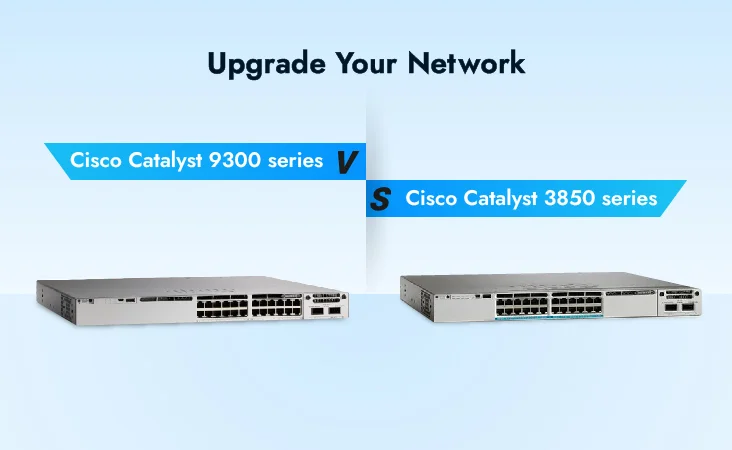 15
15In the rapidly evolving world of online networking, being ahead of the curve is not only advantageous but also essential. As a pioneer in the networking industry, Cisco has consistently evolved its Catalyst series switches to satisfy the ever-growing demands of modern businesses. One such transition worth exploring is the move from the Cisco Catalyst 3850 series to the Cisco Catalyst 9300 series switches.
This guide is intended to help network planners and engineers who are experienced with Cisco Catalyst 3850 and want to move forward to Cisco Catalyst 9300 series switches in the enterprise networking environment.
The Cisco Catalyst 3850 switch series is a reliable network of switches for many enterprises that offers a mix of performance and features. However, as technology has advanced, so have the challenges and requirements of a powerful network infrastructure.
Cisco Catalyst 3850 series switches are multigigabit and 10Gb switches that support Cisco StackWise-480 Technology, which allows them to stack with up to 9 switches and support 480 Gbps stackable bandwidth.
The Catalyst 3850 Series has been a great success, but it is not without its limitations. This includes limited scalability- and the lack of certain networking features.
An upgrade to the Catalyst series is a strategic decision in order to meet the demands of data intensive applications and the increasing number of connected devices.
The new Cisco Catalyst 9300 Series switches are Cisco's response to the changing dynamics of networking and are the best stackable access switches. Built for security, IoT, mobility, and the cloud, these network switches form the foundation for Cisco's S-D Defined Access.
Cisco Catalyst 9300 series switches present a compelling case for organizations contemplating an upgrade with its advanced features and improved capabilities.
The Catalyst Series 9300 offers significant performance improvements, including higher bandwidth and greater scalability. This results in smoother operations, and the ability for modern networks to handle the growing load.
Security is non-negotiable in an age where cyber threats have become more sophisticated. The 9300 series features advanced security protocols that provide a robust defense from potential cyber-attacks.
The Catalyst series, which adapts to the software-defined network (SDN) era, allows more flexibility and control of network resources. This paves the way for an infrastructure that is more dynamic and responsive.
The new Catalyst 9300 series should be more powerful than the Catalyst 3850 switches.
Table 1. shows comparison of the Cisco Catalyst 3850 Series and Catalyst 9300 switches.
|
Feature |
Cisco Catalyst 3850 Series |
Cisco Catalyst 9300 |
|
Switch Models |
Various models with different port configurations and uplink options |
Various models with different port configurations and uplink options |
|
Stacking Technology |
StackWise-480 |
StackWise-480 |
|
Uplink Ports |
1/10 Gigabit Ethernet or 1/10/25/40/100 Gigabit Ethernet |
1/10 Gigabit Ethernet or 1/10/25/40/100 Gigabit Ethernet |
|
Power over Ethernet (PoE) |
Yes, with various power budgets depending on the model |
Yes, with various power budgets depending on the model |
|
Multigigabit Ethernet |
Available on certain models |
Available on certain models |
|
Wireless LAN Controller |
Integrated (depending on the model) |
Integrated (depending on the model) |
|
Modular Uplinks |
Yes, with module options |
Yes, with module options |
|
Routing Capabilities |
IP Base and IP Services licenses for Layer 3 capabilities |
IP Base and IP Services licenses for Layer 3 capabilities |
|
MACsec Encryption |
Available on certain models |
Available on certain models |
|
Network Essentials/Advantage |
Available on certain models |
Available on certain models |
|
SD-Access Support |
Yes |
Yes |
|
Software-Defined Networking (SDN) |
Yes (with Cisco DNA) |
Yes (with Cisco DNA) |
|
Ease of Management |
Cisco Prime Infrastructure, Cisco DNA Center |
Cisco Prime Infrastructure, Cisco DNA Center |
|
Power Supply Redundancy |
Yes, with dual redundant power supplies |
Yes, with dual redundant power supplies |
|
Operating System |
Cisco IOS XE |
Cisco IOS XE |
The default system behavior of the Cisco 9300 Series is almost identical to that of the Cisco Catalyst 3850 Series. The interfaces are set to Layer 2 switch mode by default, IP routing has been disabled, and the management interface runs in a dedicated Virtual Routing and Forwarding instance (VRF). There is a difference in control plane policy for the Catalyst Series 3850 when it is running Release 3.X. Control Plane Police (CoPP) is enabled in the Cisco Catalyst 9300 Series. It has a default policing rate for different traffic classes. These policing rates are optimized for typical campus environments. For different application environments, the policing rate can be altered or disabled. Switches from the Cisco Catalyst Series 3850 come with CoPP turned off by default. However, the system offers a macro that allows the user to specify the policing rates for each class.
Cisco Catalyst Series 3850 switches and Cisco Catalyst 9300 switches are flexible networking solutions that are designed to meet the needs of any enterprise. Catalyst 3850 series provides scalable port configurations and advanced security features. Its StackWise 48 technology allows flawless bandwidth. Whereas, Cisco Catalyst 9300 offers flexible port configurations, integrated wireless controllers, and security features such as MACsec, TrustSec, etc. The switches are reasonably priced and run on Cisco IOS Software XE, which provides dependable and secure performance along with the integration of energy-efficient technologies for eco-friendly operations. These switches offer high-performance connectivity for modern networking needs with their modular uplinks and support of Multigigabit Ethernet.
Table 2. shows the specifications between Cisco Catalyst 3850 and Catalyst 9300 series switches down below.
|
Feature |
Cisco Catalyst 3850 Series |
Cisco Catalyst 9300 |
|
Switch Models |
Various models with different port configurations and feature sets |
Various models with different port configurations and feature sets |
|
Ports |
24 to 48 ports, supporting Gigabit Ethernet or Multigigabit Ethernet |
24 to 48 ports, supporting Gigabit Ethernet or Multigigabit Ethernet |
|
Uplink Interfaces |
4x1G, 2x10G, 4x10G, or 2x40G fixed uplinks, or modular uplinks with higher speed options |
4x1G, 2x10G, 4x10G, or 2x40G fixed uplinks, or modular uplinks with higher speed options |
|
Stacking Capability |
Stackable with Cisco StackWise-480 technology, supporting up to 480 Gbps of stacking bandwidth |
Stackable with Cisco StackWise-480 technology, supporting up to 480 Gbps of stacking bandwidth |
|
Power over Ethernet (PoE) |
Available on selected models, providing PoE, PoE+, or UPOE |
Available on selected models, providing PoE, PoE+, or UPOE |
|
Wireless LAN Controller |
Integrated wireless controller for managing Cisco Aironet access points |
Integrated wireless controller for managing Cisco Aironet access points |
|
Software Support |
Cisco IOS XE Software |
Cisco IOS XE Software |
|
Security Features |
TrustSec, MACsec, Cisco ISE integration, Secure Group Tagging (SGT) |
TrustSec, MACsec, Cisco ISE integration, Secure Group Tagging (SGT) |
|
QoS (Quality of Service) |
Advanced QoS with support for Auto-QoS and custom policies |
Advanced QoS with support for Auto-QoS and custom policies |
|
Multigigabit Ethernet |
Supports Multigigabit Ethernet for higher-speed connectivity to devices such as 802.11ac Wave 2 access points |
Supports Multigigabit Ethernet for higher-speed connectivity to devices such as 802.11ac Wave 2 access points |
|
Modular Uplinks |
Modular uplink options for flexibility in uplink speed and type |
Modular uplink options for flexibility in uplink speed and type |
|
Energy Efficiency |
Energy-Efficient Ethernet (EEE), Cisco EnergyWise technology |
Energy-Efficient Ethernet (EEE), Cisco EnergyWise technology |
|
Dimensions (H x W x D) |
Varies by model |
Varies by model |
|
Weight |
Varies by model |
Varies by model |
Both the Cisco Catalyst 3850 series and Catalyst 9300 switches offer modular uplinks that provide flexibility in designing the network to specific connectivity needs. These modular interfaces support various uplink speeds and types, allowing organizations to adapt to evolving network requirements. Whether it's 1 Gigabit, 10 Gigabit, or 40 Gigabit Ethernet, the modular design ensures scalability and future-proofing for diverse network switches.
Table 3. below enlist the modular uplinks between the Cisco 3850 and Catalyst 9300 switches.
|
Feature |
Cisco Catalyst 3850 Series |
Cisco Catalyst 9300 |
|
Uplink Module Options |
C3850-NM-4-1G, C3850-NM-2-10G, C3850-NM-4-10G |
C9300-NM-4M, C9300-NM-8X, C9300-NM-2Q, C9300-NM-4Q |
|
Maximum Uplink Bandwidth |
Up to 80 Gbps (depending on module configuration) |
Up to 40 Gbps (depending on module configuration) |
|
Uplink Module Compatibility |
Compatible with various Cisco uplink modules |
Compatible with specific Catalyst 9300 Network Modules |
|
Supported Uplink Speeds |
1 Gbps, 10 Gbps |
1 Gbps, 10 Gbps, 25 Gbps, 40 Gbps, and 100 Gbps |
|
Uplink Ports per Module |
Varies based on module (e.g., 4 x 1G, 2 x 10G) |
Varies based on module (e.g., 4 x 1G, 2 x 10G, 4 x 25G) |
|
Hot-Swappable Modules |
Yes |
Yes |
|
Redundancy Support |
Yes (with redundant power supplies) |
Yes (with redundant power supplies) |
|
Compatibility with StackWise Technology |
Yes |
Yes |
|
Supported Fiber Optic and Copper Cabling |
Yes |
Yes |
|
Cisco StackPower Support |
Yes (available with certain models) |
Yes (available with certain models) |
|
Power over Ethernet (PoE) Support |
Yes (available with certain models) |
Yes (available with certain models) |
Strong power redundancy features are included in the Cisco Catalyst 3850 and 9300 switches to improve network dependability. These switches have redundant power supply options, so they can keep working even if the power supply fails. Due to its dual power supply capability, which offers enterprises a resilient infrastructure that reduces downtime and guarantees continuous connectivity, mission-critical applications can operate without interruption and is affordable.
Table 4. below compares the power redundancy features between the Cisco Catalyst 3850 and Catalyst 9300 switches.
|
Feature |
Catalyst 3850 Series |
Catalyst 9300 Series |
|
Power Supply Options |
Dual redundant power supplies |
Dual redundant power supplies |
|
Power Supply Types |
AC and DC options are available |
AC and DC options are available |
|
Power Stackable |
Yes |
Yes |
|
Power Stack Capacity |
Up to 4800W (Power stack) |
Up to 4800W (Power stack) |
|
Hot Swappable Power |
Yes |
Yes |
|
Power Stack Technology |
Cisco StackPower technology |
Cisco StackPower technology |
|
Power Management Features |
Power monitoring and management through Cisco EnergyWise |
Power monitoring and management through Cisco EnergyWise |
|
Power Redundancy Modes |
N+1 and N+N |
N+1 and N+N |
|
Redundant Power Supply Configurations |
1+1 and N+N |
1+1 and N+N |
|
Power Over Ethernet (PoE) |
Supports PoE and PoE+ |
Supports PoE, PoE+, and UPoE |
|
PoE Budget |
Varies depending on model |
Varies depending on model |
Use the feature navigator at cisco.com to find out more about the Cisco Catalyst Series. Customers migrating to the Catalyst 9300 Series from the Cisco Catalyst Series 3850 will only see the following differences in features:
Cisco Catalyst 3850 supports IP Device Tracking in Release 3.X to keep track of the connected hosts (association between MAC addresses and IP addresses). Cisco Catalyst Series 9300 with the latest Cisco IOS XE Software Release supports the new Switch Integrated Security Features (SISF)-based IP Device Tracking feature. This acts as a container-policy that enables snooping, device tracking and First Hop Security (FHS) in IPv4 or IPv6 using IP-agnostic Command-Line Interface commands. For more information about migrating to the new SISF device tracking CLI configuration, see Appendix A.
The Cisco Catalyst Series 9300 supports the latest ASICs and operating systems. The Catalyst 9300 Series supports per-port queuing policies, where each uplink or downlink port can have its own egress queueing policy. Cisco Catalyst Series 3850 supports a single egress queueing policy for all uplinks and downlinks.
Table 5 summarizes the Quality of Service (QoS) specifications for the Cisco Catalyst 3850 Series and Catalyst 9300 Series switches:
|
Feature |
Cisco Catalyst 3850 Series |
Cisco Catalyst 9300 Series |
|
QoS Models Supported |
MQC (Modular QoS Command-Line Interface) |
MQC (Modular QoS Command-Line Interface) |
|
Number of QoS Classes |
8 |
8 |
|
Classification and Marking |
Yes |
Yes |
|
Policing and Shaping |
Yes |
Yes |
|
Queuing Algorithms |
WRR (Weighted Round Robin), Strict Priority |
WRR (Weighted Round Robin), Strict Priority |
|
Class-Based Policing |
Yes |
Yes |
|
Policing Rate |
Per-class or aggregate |
Per-class or aggregate |
|
Shaping Rate |
Per-port or per-class |
Per-port or per-class |
|
Congestion Avoidance |
WRED (Weighted Random Early Detection) |
WRED (Weighted Random Early Detection) |
|
Auto-QoS |
Yes |
Yes |
|
Voice VLAN |
Yes |
Yes |
|
Voice and Video Quality Metrics |
Yes |
Yes |
|
Trust Boundaries |
Port-based, VLAN-based, and DSCP-based |
Port-based, VLAN-based, and DSCP-based |
|
IPv6 QoS Support |
Yes |
Yes |
|
Multicast QoS Support |
Yes |
Yes |
|
Per-Port QoS Configuration |
Yes |
Yes |
|
Modular QoS CLI (MQC) |
Yes |
Yes |
|
QoS Monitoring and Reporting |
Yes |
Yes |
Cisco Catalyst 3850 Series Multi Gigabit switches have Gigabit Ethernet and 10G Ethernet ports only. Cisco Catalyst 9300 Series Multigigabit switches have introduced support for 1G, 2.5G, 5G and 10G Ethernet on the 48-port Multigigabit switches.
Table 6. Presence of 2 Gigabit Ethernet ports on the Cisco Catalyst 3850 Series and Catalyst 9300 Series
|
Series |
Model |
Number of Gigabit Ethernet Ports |
|
Cisco Catalyst 3850 Series |
[Model Name] |
2 |
|
Cisco Catalyst 9300 Series |
[Model Name] |
2 |
The management interface on the Cisco Catalyst 9300 Series is Gigabit Ethernet, which is very similar to the Gigabit Ethernet interface on the Catalyst 3850 Series. The management port on both platforms has its own VRF instance for separation of management traffic from normal data traffic.
Table 7. compares some technical differences between Catalyst 3850 series and Cisco Catalyst 9300 switches.
|
Feature |
Catalyst 3850 Series |
Catalyst 9300 Series |
|
Maximum Bandwidth |
480 Gbps |
1.44 Tbps |
|
Maximum VLANs |
4096 |
4096 |
|
Power over Ethernet (PoE) |
Yes |
Yes |
|
StackWise Virtual |
No |
Yes |
|
Software-Defined Access |
No |
Yes |
Table 8. provides increased port density and higher switching capacity, allowing for the expansion of network infrastructure to accommodate growing business needs.
|
Feature |
Catalyst 3850 |
Catalyst 9300 |
|
Maximum Ports |
Up to 48 ports (3850-48U) |
Up to 48 ports (9300-48UXM) |
|
Switching Capacity |
101.2 Mpps (3850-48U) |
202.38 Mpps (9300-48UXM) |
|
VLANs |
4,000 |
4,094 |
Cisco Catalyst 3850 series switches support only weighted tail drop (WTD), which eliminates the packets based on configured thresholds. Whereas, Cisco Catalyst 9300 series switches use both WTD and Weighted Random Early Detection (WRED), which eventually discards packets at the specified thresholds based on their IP precedence; Differentiated Services Code Point (DSCP); or the Class of Service (CoS), which gives the network architect much more control over the drop behavior.
Want to buy this series of products? please contact:
ORM Systems is global IT hardware and Software Solution provider. Our core focus is providing authentic, reliable, and cost-effective IT hardware products along with enterprise software solutions. Our superior customer service team has built a strong correlation between our customers and suppliers. We have laid out our physical presence by having operational branches and warehouses in the UK, USA, Europe and the Middle East. We stock huge inventory globally and provide fast delivery to an absolute supply chain and logistics for our consumers all around the world, with a guarantee of meeting your standard requirements.
To sum up, switching to the Catalyst 9300 series switches will ensure that your network infrastructure is ready to handle the demands of changing business requirements. These upgrades offer significant gains in performance, scalability, features, security, and management capabilities.
Related Topics:
Cisco Nexus Vs Catalyst Switches: what’s the difference?
Battle of the Brands: Cisco Switches vs Huawei Switches
Cisco 9200 VS 9300 series switches: Head-to-Head Comparison
Q1: What are the key differences between Catalyst 3850 and 9300 series switches?
A1: The Catalyst 9300 series boasts enhanced performance, advanced security features, and software-defined networking capabilities compared to the Catalyst 3850 series. The 9300 series is designed to meet the evolving demands of modern networking.
Q2: Is the upgrade process time-consuming?
A2: The migration process from Catalyst 3850 to 9300 series switches is carefully outlined in our guide to ensure a seamless transition. While the timeline may vary, our step-by-step approach minimizes downtime and disruptions.
Q3: How can small businesses benefit from Catalyst 9300?
A3: Small businesses can benefit from the improved speed, efficiency, and scalability of the Catalyst 9300 series. Our article provides insights into developing the upgrade strategy for businesses of all sizes, ensuring a cost-effective and impactful transition.
Q4: Are there any downsides to upgrading?
A4: While the benefits of upgrading are substantial, it's essential to address potential challenges. Our article discusses common concerns and provides practical solutions to ensure a smooth upgrade process with minimal disruptions.
Q5: What kind of technical support is available post-upgrade?
A5: Cisco offers robust technical support for Catalyst series switches. Post-upgrade, businesses can leverage Cisco's support services to address any technical issues and ensure the optimal performance of their network infrastructure.
quRecent Posts
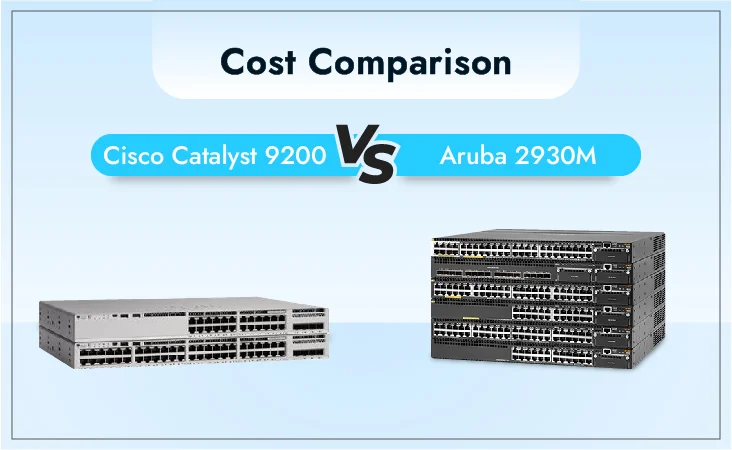
Cisco Catalyst 9200 Switches vs Aruba 2930M Switches: Comparing Prices
30 April-2024
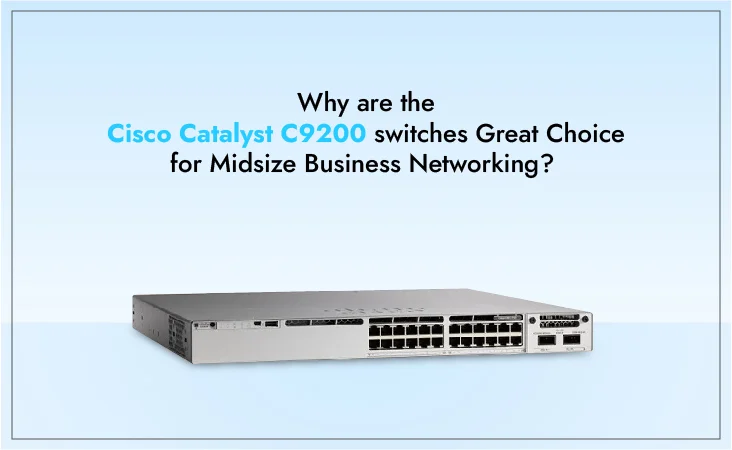
What Makes the Cisco Catalyst C9200-24P-A Switch Ideal for Medium-Sized Businesses?
30 April-2024
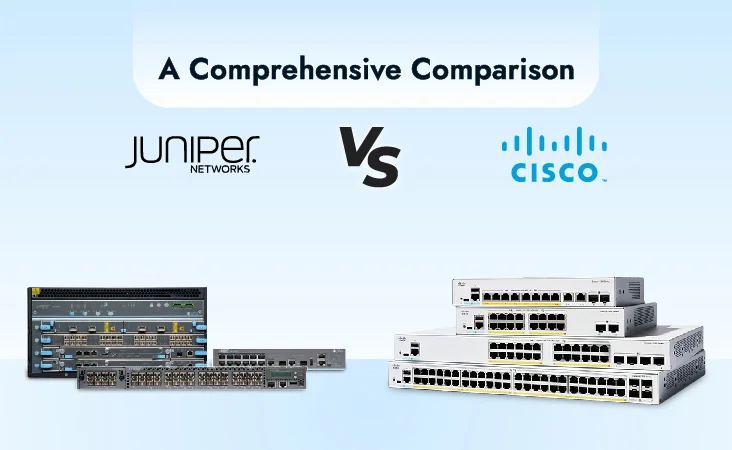
Cisco vs Juniper: A Comprehensive Comparison
26 April-2024

Cisco vs Juniper: A Comprehensive Network Comparison
26 April-2024
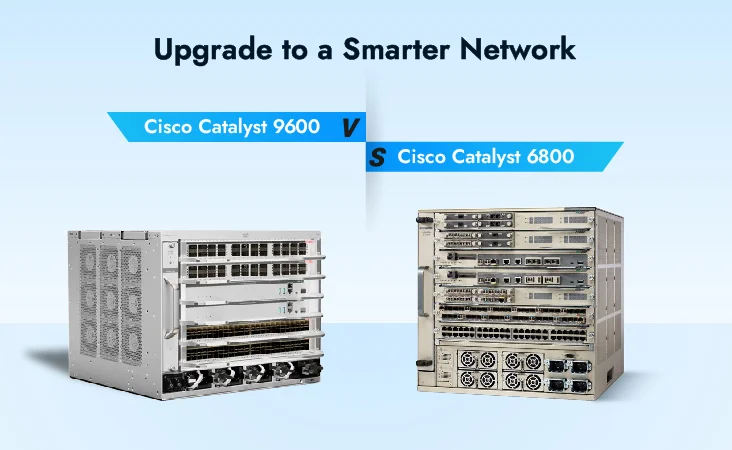
Cisco Catalyst 9600 vs Cisco Catalyst 6800 Series Switches: Upgrade to a Smarter Network
25 April-2024
Most Used Tags
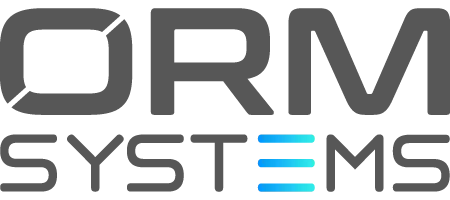
Developing performance-driven networks to boost the efficiency of your business

Thank you for your interest in ORM systems, our experts will connect with you shortly.
 +1 (281)
747-5957
+1 (281)
747-5957


